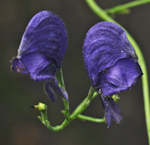
 Aconitum has somewhere between 50 and 300
species depending on the
taxonomist
consulted.
Aconitum has somewhere between 50 and 300
species depending on the
taxonomist
consulted.
This
genus is known for its uniquely shaped flowers which
resemble the hooded garment worn by ancient
monks. Monkshoods generally grow in sun or shaded
gardens and form tall (3-6 feet) flower spikes in the fall.
Blooms are generally in
shades of blue although some varieties have been
developed with white or yellow flowers.
 The roots, leaves and seeds
of Aconitum are poisonous and very dangerous if
eaten or if their juices get into scratches.
They contain a narcotic alkaloid chemical called aconitin. Care should be taken when
transplanting or handling monkshoods to avoid
getting any of the sap from the plant into your
mouth.
The roots, leaves and seeds
of Aconitum are poisonous and very dangerous if
eaten or if their juices get into scratches.
They contain a narcotic alkaloid chemical called aconitin. Care should be taken when
transplanting or handling monkshoods to avoid
getting any of the sap from the plant into your
mouth.
Monkshoods do best in partial
shade and a cool, moist soil enriched with
compost or leaf mold. However, they will also
thrive in full sun if given enough soil moisture
during the growing season. It is generally
believed that monkshoods suffer severely when
their roots are disturbed, so care should be
taken when transplanting or dividing them in the
garden.



